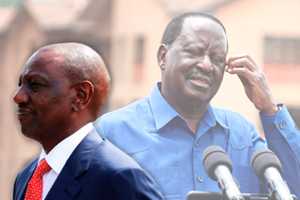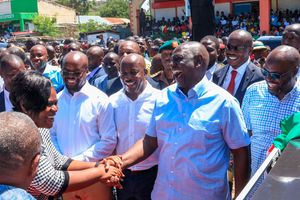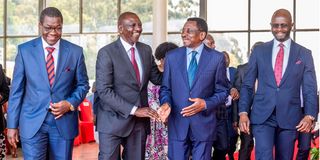
President William Ruto with Siaya Governor James Orengo (second right), Energy Cabinet Secretary Opiyo Wandayi (left) and Alego Usonga MP Samuel Atandi when he hosted leaders and business people from Siaya County at State House, Nairobi.
President Jomo Kenyatta and his successor Daniel arap Moi started the tradition of meeting delegations at State House but since 2022 President William Ruto has perfected the practice with the number of visits to Nairobi’s seat of power intensifying in recent weeks.
Scenes of busloads of people flocking State House and leaving with smiles on their faces and something in their tummies and pockets are playing out more frequently. Often, these are delegations seeking to lobby for development projects in their regions, government jobs or various favours.
President Ruto has stepped up a flurry of engagements at State House, hosting dozens of delegations – at least 25 this year alone – drawn from religious leaders, political figures, professional bodies, and grassroots networks across the country.
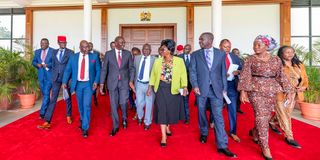
President William Ruto with members of Parliament from Vihiga, Kakamega, Busia, Bungoma and Trans-Nzoia Counties at State House, Nairobi on June 5, 2025.
“[This is] a deliberate attempt to revive the old Kanu trick akin to the YK92 which Ruto was part of when they spent a lot of money on voters,” says Prof Gitile Naituli, a lecturer at Multimedia University of Kenya.
With his deputy Prof Kithure Kindiki also in tow, through his engagements at his official Karen residence, the president’s charge is seen as a calculated move to broaden his political appeal ahead of the 2027 General Election.
In what observers are now terming the “politics of delegations,” the Head of State has since his swearing in September 2022 presided over more than 60 high-level publicised meetings – 25 of them in 2025 alone – each aimed at winning over key constituencies and forging new political alliances.
There is, expectedly, a lot more such delegation meetings that are not publicised and the meeting will, therefore, be a lot more.
Political-cum-development meetings
The trend has taken root so firmly that former Deputy President Rigathi Gachagua has begun to feel the heat, especially as his successor Prof Kindiki ramp up parallel engagements at his residence.
A recent public spat between Mr Gachagua and Prof Kindiki over a meeting the latter held with Mt Kenya artists underscored growing tensions over control of the region’s political narrative.
On Thursday, President Ruto held two key political-cum-development meetings at State House, Nairobi, hosting leaders from perceived 2022 opposition strongholds, as he puts his best foot forward ahead of the 2027 poll.
He met MPs from Vihiga, Kakamega, Busia, Bungoma and Trans-Nzoia Counties—which cumulatively boast of 2.2 million voters — as well as a delegation from Siaya County led by Governor James Orengo, seen as the last convert in the Raila Odinga Nyanza political bedrock.
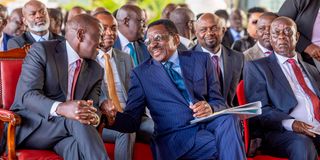
President William Ruto, Siaya Governor James Orengo and the Senator Oburu Oginga when he hosted leaders and business people from the county at State House, Nairobi on June 5, 2025.
Earlier on the same day, Dr Ruto hosted a notable delegation from Siaya County led by Mr Orengo, Senator Oburu Oginga, and Energy Cabinet Secretary Opiyo Wandayi.
The high-level meeting, like the one with Western leaders on sugarcane, unlocked multi-billion-shilling infrastructure and development pledges for the county — a significant political moment given Mr Orengo’s long-standing opposition to the Ruto-ODM leader Raila Odinga broad-based government.
“The delegation met the president to discuss ongoing and upcoming National Government projects in the county. We explored partnership opportunities aimed at strengthening collaboration between the National and County Governments to foster inclusive development and enhance service delivery for the people of Siaya,” Mr Orengo said after the meeting.
But the Siaya delegation is just part of a broader trend.
Since assuming office, President Ruto has methodically met with leaders from traditionally opposition strongholds such as Nyanza, Western, Coast, and parts of Mt Kenya, often bringing along goodies such as road projects, industrial parks, housing units, and funding for SMEs.
State House spokesperson Hussein Mohamed insisted that there was nothing new with what President Ruto and Prof Kindiki were doing, saying the Head of State has always “prioritised consultations” with all cadres of people, political and religious leaders, professional associations, grassroots opinion shapers, and ordinary citizens.
“Engaging such a wide array of stakeholders is one of the most effective ways to promote a deeper understanding of public policy among both leaders and the general public. President Ruto’s approach over the past 30 years, which is combining public rallies, meetings with leaders from various sectors, and empowerment initiatives, has never been about choosing one over the other. These long-established approaches are not mutually exclusive; rather, they complement each other and together form a broader framework for direct engagement with citizens across the country,” Mr Mohamed told the Nation.
He also insisted that the empowerment programmes spearheaded by Prof Kindiki “are not a new invention.”
“They (empowerment programmes) have been a hallmark of President Ruto’s political journey and are, in fact, the foundation that evolved into the Bottom-Up Economic Transformation Agenda (BETA),” the State House aide said.
According to Kenya Kwanza administration insiders, these curated meetings give the President a more effective channel for political engagement compared to traditional rallies.
In closed-door sessions, Dr Ruto is said to gather unfiltered feedback from local leaders, religious figures, professionals, and grassroots mobilisers — all while building bridges to bolster his re-election bid.
“The President values these meetings because they offer him candid insight into the real issues affecting different communities. It also allows him to directly communicate government plans without political noise,” said a senior aide familiar with the meetings.
These engagements, often announced with curated photo-ops and social media updates, serve a dual purpose: showcasing inclusivity and leveraging the “soft power” of religious and professional groups to sway public opinion.
But whereas Kenya Kwanza-allied leaders have defended such meetings, some political observers have dismissed them as mere campaign alignments.
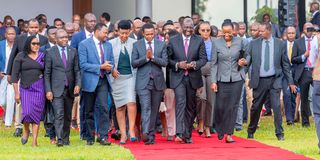
President William Ruto with leaders from Machakos, Makueni and Kitui at State House, Nairobi on May 21, 2025.
“These are signs of desperation,” says United States International University-Africa lecturer Prof Macharia Munene.
“Yes, the president and his deputy are simply campaigning because Kalonzo Musyoka and Wamunyoro (Mr Gachagua) appear to resonate with the public.”
Uriri MP Mark Nyamita (ODM) however, noted that the State House meetings were justified, adding that campaigns are yet to begin.
“There has been a lot of negative energy being spread by those who are out of power after a long time and this has led to a lot of misinformation to the public...This government has therefore opted to have smaller delegations to help them appreciate the progress we are making a nation after many years of missed opportunities,” Mr Nyamita told Nation.
According to Mr Nyamita, a staunch supporter of the broad-based administration, the government’s approach is deliberate — aimed at offering local leaders a clearer view of the government’s progress and development priorities.
Kitui South MP Rachel Nyamai also termed the meetings as a “good move” over their developmental oriented agenda.
However, Prof Naituli, the Multimedia University don, was blunt in his assessment, dismissing the State House delegations as nothing more than “paid-for meetings”.
“These State House delegations are paid for using taxpayers’ money in order to influence support,” Prof Naituli noted.
Without adducing evidence, he said: “I know for a fact that those who attend the meetings are paid depending on the value they have about you. I know of a delegation from Mt Kenya that was paid between Sh20, 000 and Sh50, 000.”
“But I want to say they are a complete waste of time and the government needs to get better advice on what empowerment means. You cannot, for instance, purport to revive sugarcane farming when you are leasing factories for 50 years and also allowing importation of sugar,” added Prof Naituli.
DP Kindiki recently hit out at his predecessor, Mr Gachagua, who appeared to criticise Mt Kenya artists he had hosted at his Karen residence.
“Some people think they can sneak around and divide the Mountain. We know who the real leaders are,” Mr Gachagua said in a veiled attack.
But Prof Kindiki swiftly responded: “Leadership is not about noise. It’s about ideas, unity and delivery. The mountain will not be held hostage by entitlement.”
Dr Ruto’s approach is widely viewed as a revival of former presidents Jomo Kenyatta and Daniel Moi’s tactics but a sharp deviation from Mr Mwai Kibaki’s and Mr Uhuru Kenyatta’s reliance on centralised power.
Instead, he appears to be decentralising political engagement by tapping into local networks and identities — particularly in counties where he faced stiff resistance in 2022.
“President Ruto is not waiting for campaigns to begin. He is campaigning now, every day, through service delivery, inclusion and by making even his fiercest critics feel heard,” another observer said.
Whether this tactic will translate into actual votes remains to be seen, even as Prof Gitile dismissed it as “untenable since Kenyans have already made up their minds and need tangible developments, not inducements”.

